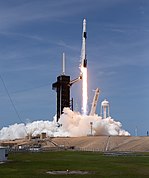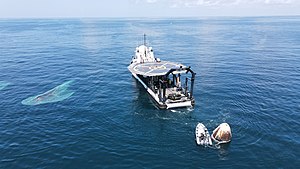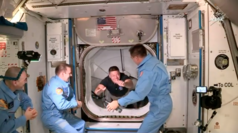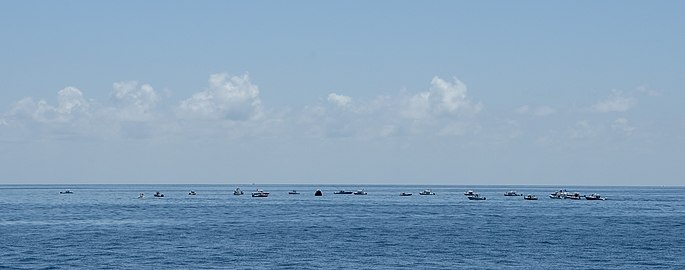Crew Dragon Demo-2
Clockwise from top left: Falcon 9 withEndeavourlaunches from LC-39A,Endeavourapproaches the ISS, recovery ofEndeavour | |
| Names |
|
|---|---|
| Mission type | Flight test |
| Operator | SpaceX |
| COSPAR ID | 2020-033A |
| SATCATno. | 45623 |
| Mission duration | 63 days, 23 hours, 25 minutes, 21 seconds |
| Spacecraft properties | |
| Spacecraft | Crew DragonEndeavour |
| Spacecraft type | Crew Dragon |
| Manufacturer | SpaceX |
| Launch mass | 12,519 kg (27,600 lb)[1] |
| Landing mass | 9,616 kg (21,200 lb)[1] |
| Crew | |
| Members | |
| Expedition | Expedition 63 |
| Start of mission | |
| Launch date | 30 May 2020, 19:22:45UTC(3:22:45pmEDT)[2] |
| Rocket | Falcon 9 Block 5(B1058.1) |
| Launch site | Kennedy,LC-39A |
| End of mission | |
| Recovered by | MVGO Navigator |
| Landing date | 2 August 2020, 18:48:06UTC (1:48:06pmCDT)[3] |
| Landing site | Gulf of Mexico,nearGulf Shores, Alabama(29°47′43″N87°31′47″W/ 29.79528°N 87.52972°W)[2] |
| Orbital parameters | |
| Reference system | Geocentric orbit |
| Regime | Low Earth orbit |
| Inclination | 51.66° |
| Docking withISS | |
| Docking port | Harmonyforward[4] |
| Docking date | 31 May 2020, 14:27UTC[5][6] |
| Undocking date | 1 August 2020, 23:35UTC |
| Time docked | 62 days, 9 hours, 8 minutes |
  NASA and SpaceX mission patches 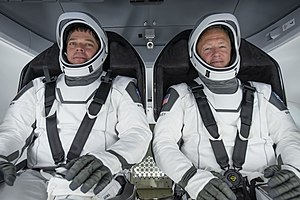 BehnkenandHurley | |
Crew Dragon Demo-2(officiallyCrew Demo-2,SpaceX Demo-2,orDemonstration Mission-2)[a]was the first crewedtest flightof theCrew Dragonspacecraft. The spacecraft, namedEndeavour,launched on 30 May 2020[7][11][12]on aFalcon 9rocket, and carriedNASAastronautsDoug HurleyandBob Behnkento theInternational Space Stationin the first crewed orbital spaceflight launched from the United States since thefinal Space Shuttle missionin 2011, and the first ever operated by a commercial provider.[13]Demo-2 was also the first two-person orbital spaceflight launched from the United States sinceSTS-4in 1982. Demo-2 completed the validation of crewed spaceflight operations usingSpaceXhardware and receivedhuman-rating certificationfor the spacecraft,[14][15]including astronaut testing of Crew Dragon capabilities on orbit.[15]
Docking was autonomously controlled by the Crew Dragon, but monitored by the flight crew in case manual intervention became necessary.[16]The spacecraftsoft dockedwith the International Space Station on 31 May 2020, nineteen hours after launch. Following soft capture, 12 hooks were closed to complete a hard capture 11 minutes later.[5]Hurley and Behnken worked alongside the crew ofExpedition 63for 62 days, including fourspacewalksby Behnken with fellow American astronautChris Cassidyto replace batteries brought up by aJapanese cargo vehicle.Endeavourautonomously undocked from the station on 1 August 2020 and thirteen hours later returned the astronauts toEarthin the firstwater landingby astronauts since 1975.[17]
Background
[edit]After theSpace Shuttle programwasbrought to an endin 2011,NASAno longer had a spacecraft system capable of sendinghumans to space.As a result, it was forced to fly its astronauts to theInternational Space Station(ISS) aboard the RussianSoyuz space vehicle,at a cost of up to US$80 million per astronaut. As an alternative, NASA contracted with private companies such asSpaceXfor theCommercial Crew Program,which is expected to cost 50% less than Soyuz once in regular operation.[18]Up to the launch, NASA has awarded a total of US$3.1 billion for the development of theDragon 2.[19]The Demo-2 mission was SpaceX's last major test before NASA certified it for regularcrewed spaceflights.[13]Prior to that, SpaceX had sent twenty cargo missions to the ISS, but never a crewed one.[19]Boeingwas separately working on crewedorbital spaceflightunder the same NASA effort.[13]
Crew
[edit]Doug Hurley and Bob Behnken were announced as the primary crew on 3 August 2018.[20]Both astronauts are veterans of the Space Shuttle program,[21]and the Demo-2 flight was the third trip to space for both of them. The lead flight director for this mission was Zebulon Scoville.[22]
NASA astronautKjell Lindgrenwas the sole backup crew member for the flight, backing up both Hurley and Behnken for the mission.[23]
| Position[16] | Astronaut | |
|---|---|---|
| Spacecraft commander | Doug Hurley Expedition 63 Third and last spaceflight | |
| Joint operations commander | Bob Behnken Expedition 63 Third and last spaceflight | |
| Position | Astronaut | |
|---|---|---|
| Commander | Kjell Lindgren | |
Insignia and livery
[edit]The mission insignia was designed by artist Andrew Nyberg fromBrainerd, Minnesota,a nephew of spacecraft commander Hurley.[24]The insignia features the logos of theCommercial Crew Program,Falcon 9,Crew Dragon,and the red chevron ofNASA's "meatball" insignia.Also depicted are theAmerican flagand a graphic representation of the ISS. The wordsNASA, SPACEX, FIRST CREWED FLIGHTandDM-2are printed around the border along with the surnames of the astronauts. The insignia outline is in the shape of the Crew Dragon capsule.[25]
The Falcon 9 rocket used to launchEndeavourdisplayed NASA's"worm" insignia,the first time the logo had been used officially since it was retired in 1992.[26]NASA TVand media coverage of the launch was branded as "Launch America",with its own logo.[27][28]
The SpaceX patch shows the top of the company's spacesuit, with the ISS and North America portrayed on the helmet shield and a white star denoting thelaunch siteatCape Canaveral.Behind the suit are the American flag, and around the insignia's black borderSPACEX DRAGONandNASA DEMO-2are written in white, alongside the names of the two astronauts at the bottom; with acloverleafbetween the two names.
Pre-launch processing
[edit]

NASA calculated the loss-of-crew (LOC) probability for the test flight as 1-in-276, better than the commercial crew program requirement threshold of 1-in-270. The 1-in-276 number included mitigations to reduce the risk, such as on-orbit inspections of theCrew Dragonspacecraftonce it wasdockedto the space station to look for damage frommicrometeoroidsandorbital debris(MMOD). NASA pegged the overall risk of a loss of mission (LOM) as 1-in-60, covering scenarios where the Crew Dragon does not reach the space station as planned, but the crew safely returns to Earth.[29]
The Crew Dragon Demo-2 mission was initially planned for launch in July 2019 as part of theCommercial Crew Programcontract with a crew of two on a 14-day test mission to the ISS.[30][20]The Crew Dragon capsule from theCrew Dragon Demo-1mission was destroyed while itsSuperDracothrusters were undergoing static fire testing on 20 April 2019, ahead of its planned use forthe in-flight abort test.[31][32]SpaceX traced the cause of the anomaly to a component that leakedoxidizerinto the high-pressure helium lines, which then solidified and damaged a valve. The valves were since switched forburst discsto prevent another anomaly.[33]On 19 January 2020, a Crew Dragoncapsulesuccessfully completed an in-flight abort test.[34]NASA AdministratorJim Bridenstinesaid on 9 April 2020 that he was "fairly confident" that astronauts could fly to the ISS aboard SpaceX's Crew Dragon spaceship at the end of May or in early June 2020, pending final parachute tests, data reviews and a training schedule that could escape major impacts from the ongoingCOVID-19 pandemic.[35]
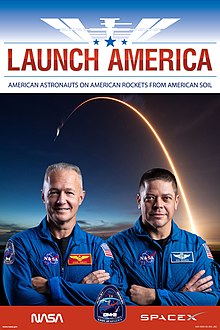
On 17 April 2020, NASA and SpaceX announced the launch date as 27 May 2020.[15]The arrival of theCrew Dragonwill have raised the station's crew size from three to five. Bob Behnken and Doug Hurley will have performed duties and conducted experiments as crew on board the ISS for several months. Hurley and Behnken were expected to live and work aboard the space station for two or three months, and then return to Earth for a splashdown in theAtlantic Oceaneast ofCape Canaveral.[15][35]NASA AdministratorJim Bridenstineurged space enthusiasts not to travel to the Kennedy Space Center to view the launch and asked people to instead watch the launch on television or online. Bridenstine explained that maintenance crews were working in cohesive shifts, to mitigate workers' exposure toSARS-CoV-2.[36]On 1 May 2020, SpaceX successfully demonstrated the Mark 3 parachute system, a critical milestone for the mission approval.[37]Crew Dragon Demo-2 marked the first crewed United States spaceflight mission not to include the presence of the public at theKennedy Space Center Visitor Complexdue to theCOVID-19 pandemic.[38]As the mission was previously delayed, the Visitor Complex opened as of 28 May 2020 with limited capacity for publicly viewing the launch. Admissions sold out almost immediately.[39]To engage the public, notably the Class of 2020, who were unable to attend their graduations due to the COVID-19 pandemic, both NASA and SpaceX invited students and graduates to submit their photos to be flown to the ISS.[40]
Behnken and Hurley arrived atKennedy Space Centeron 20 May 2020 in preparation for the launch. On 21 May 2020, the Falcon 9 rocket wasrolled outto the launch pad, and astatic fire testwas conducted on 22 May 2020, a major milestone ahead of the launch.[41]The mission used aTesla Model Xto transport Hurley and Behnken toLC-39A.[42]
Launch attempts
[edit]An official launch weather forecast for Dragon Crew Demo-2 by the45th Weather Squadronof theU.S. Space Force,for the original launch time at 20:33:33UTC on 27 May 2020, predicted a 50% probability of favorable conditions. The launch was scrubbed at T−16:53 minutes due to thunderstorms and light rain in the area caused byTropical Storm Bertha.[43][44]The second launch attempt also faced a 50% probability of favorable conditions, but was successful and took place on 30 May 2020 at 19:22:45UTC.[45][46]The other launch windows were 31 May 2020 at 19:00:07UTC, with a 60% probability of favorable conditions and 2 June 2020 at 18:13UTC with a 70% probability of favorable conditions.[47][48]
Launch attempt summary
[edit]Note: times are local to the launch site (Eastern Daylight Time).
| Attempt | Planned | Result | Turnaround | Reason | Decision point | Weather go (%) | Notes |
|---|---|---|---|---|---|---|---|
| 1 | 27 May 2020, 4:33:33 pm | Scrubbed | — | Weather | 27 May 2020, 4:16 pm(T−16:53) | 50 | Rocket generated lightning risk (field mill rule violation)[49] |
| 2 | 30 May 2020, 3:22:45 pm | Success | 2 days 22 hours 49 minutes |
Mission
[edit]Launch and orbit
[edit]
Three days after the first launch attempt was scrubbed, theCrew DragonEndeavourlaunched atop aFalcon 9rocket fromKennedy Space CenterLaunch Complex 39Aat 19:22:45UTC on 30 May 2020.[50][51]The first stage booster (serial numberB1058) landed autonomously on the floating bargeOf Course I Still Love You,which was prepositioned in the Atlantic Ocean.[52]PresidentDonald TrumpandVice PresidentMike Pence,with their wives, were at Kennedy Space Center inFloridato see the launch attempt on 27 May 2020,[53]and returned for launch on 30 May 2020.[48][54]The launch live stream was watched online by 3 million people on NASA feeds,[55]and the SpaceX feed peaked at 4.1 million viewers. NASA estimated roughly 10 million people watched on various online platforms, approximately 150,000 people gathered on Florida'sspace coast[56]in addition to an unknown number watching on television.[55]
Doug HurleyandBob Behnkenrevealed the name of theirCrew Dragoncapsule 206,Endeavour,shortly after launch, reviving another old tradition from theMercury,Gemini,andApolloprograms where astronauts would name their spacecraft.[57]It was the third U.S. spacecraft namedEndeavour,afterSpace ShuttleEndeavour,built in 1991 to replaceSpace ShuttleChallenger,which wasdestroyed in 1986,[58]and theApollo command and service moduleused for theApollo 15mission in 1971.[59]Hurley said that they choseEndeavouras both his and Behnken's first flights to space were on the ShuttleEndeavour.[6]
Each crew member brought along a toy from their family; anApatosaurusdinosaur named "Tremor" and aTyplush toy. As in past space missions, the plush toy was used as an indication ofzero gravityfor the strapped-in astronauts. Behnken and Hurley said, "That was a super cool thing for us to get a chance to do for both of our sons, who I hope are super excited to see their toys floating around with us on board".[60][61]
The crew were awakened on the second day of the flight withBlack Sabbath's "Planet Caravan".[62]NASA began a tradition of playing music to astronauts during the Gemini program, and first used music to wake up a flight crew duringApollo 15.Each track is specially chosen, often by the astronauts' families, and usually has a special meaning to an individual member of the crew, or is applicable to their daily activities.[63]
Approach, docking, and activities aboard the ISS
[edit]Nineteen hours later,Endeavourapproached the ISS. Hurley demonstrated the ability to pilot the spacecraft via its touchscreen controls until it reached a distance of 220 metres (720 ft), after whichEndeavourautonomously soft-docked to the pressurized mating adapterPMA-2on theHarmony moduleof theISSat 14:16UTC on 31 May 2020.[6][64]Following soft capture, 12 hooks were closed to complete a hard capture at 14:27UTC.[5]Approximately two hours after docking, the last of three hatches betweenEndeavourand ISS was opened and Hurley and Behnken boarded the ISS at 17:22UTC, welcomed by and joining theISS Expedition 63crew, consisting of NASA astronautChristopher "Chris" Cassidyand Russian cosmonautsAnatoly IvanishinandIvan Vagner.[6][65][66][67]
Over their time aboard the ISS, Hurley and Behnken spent over 100 hours completing science experiments, while traveling 27 million miles over their 1024 orbits of the Earth. Behnken also completed 4 spacewalks with Chris Cassidy.[68]
Undocking and return
[edit]NASA mission managers had evaluated additional sites offPanama City, Florida,Tallahassee,Tampa,andDaytona Beachto provide more options in the event of stormy tropical weather.[3]TheUnited States Coast Guardadvised against entering a 10 nmi (19 km; 12 mi) square defined in itsNotices to Marinersfor the hours leading up to splashdown noting "hazardous space operations" and theFederal Aviation Administration(FAA) restricted air traffic in the area in aNOTAM.[69]
Endeavourstayed docked to the ISS for 62 days, 9 hours and 8 minutes, undocking at 23:35UTC on 1 August 2020.[70]At the time of undocking,Endeavourweighed approximately 12,520 kg (27,600 lb).[71]The capsule completed four departure burns to move away from the ISS, followed by a phasing burn lasting over six minutes to place the capsule on a trajectory to return to Earth. The crew was awakened on the final day of the flight with prerecorded voice messages from their sons. A yaw maneuver occurred at 17:51 to separate the "claw" umbilical mechanism from the trunk.[72]
The deorbit burn of 11 minutes and 22 seconds occurred shortly after 17:56UTC. Just before reentry at 18:11UTC, the nose cone was closed. Drogue chutes deployed at 18:44UTC for approximately one minute, drawing out main parachute deployment approximately one minute later. A maximum of 4gwas experienced by Dragon capsule and its crew during the re-entry period.[72]Endeavourreturned to Earth with 150 kg (330 lb) of cargo including 90 kg (200 lb) of science cargo, mostly kept in freezers.[73]
Sixty-three days, 23 hours, 25 minutes and 21 seconds after launch, at 18:48:06UTC on 2 August 2020,Endeavoursplashed downoff the coast ofPensacola, Florida,marking the first splashdown in 45 years for NASA astronauts since theApollo–Soyuz Test Project,as well as the first splashdown of a crewed spacecraft in theGulf of Mexico.[74][75][76][77][78]After splashdown, a crew in one fast boat approached the capsule, checking the air quality for any traces of highly toxichypergolic propellantwhich could indicate a leak, while a crew in another fast boat collected the four parachutes which had disconnected from the capsule. While crews worked, many private boats entered the hazardous area defined by the Coast Guard despite earlier warnings. Some moving close to the capsule even passing between the capsule placing themselves and recovery crews themselves in danger. After radioed warnings, the boats dispersed to form a more distant ring around the capsule. TheUnited States Coast Guardsaid in a statement later that evening that previous warnings were advisory in nature; the three patrol boats in the area were stationed within their jurisdiction and did not provide sufficient resources to board vessels interfering with the recovery. The statement added that they would be reviewing events withNASAandSpaceX.[69][72]Later SpaceX and NASA confirmed that their next mission will have a 16 km (9.9 mi) enforceable keep-out zone patrolled by the U.S. Coast Guard. There will be more boats to assist in enforcing the keep-out zone.[79][80]
TheMVGO Navigator,with the assistance of a fast boat crew, attached to the capsule using a retracting A-frame device over the back to place the capsule on the "nest". The "nest" was then pulled further on board the ship where a 30-minute purge of the service section took place, as there were abnormally high levels ofdinitrogen tetroxidedetected around the capsule.[17][81]Hurley and Behnken were then greeted by crew aboardGO Navigatorand were subsequently helped out of the capsule and onto stretchers where they were taken into the onboard medical facility, before taking a helicopter back to land.[72]
Post-flight analysis of the Dragon'sheat shieldrevealed higher-than-expected erosion at four points where the capsule bolts to the trunk of the vehicle using tension ties. SpaceX stated that the erosion was likely caused by airflow phenomena that were not expected to occur around the ties. The heat shield design was changed to include more erosion-resistant materials at the ties.[79]One of four ties was noted to have deep erosion. Though it could not be determined why this was not seen during SpaceX Demo-1,Hans Koenigsmannspeculated that it may be related to different masses and trajectories flown by the spacecraft.[82]In addition, SpaceX noted that the parachutes were deployed lower than expected, but still within the allowable range. To address the issue, the instrument used to measure barometric pressure which determines altitude was replaced.[79]
-
Crew DragonEndeavourlanding in theGulf of Mexicoon 2 August 2020.
-
Support teams arrive in a fast boat at the SpaceX Crew DragonEndeavour.
-
Private boats coming close to a crew working on the capsule.
-
Large numbers of private boats create a circle around theEndeavourcapsule.
-
Endeavourbeing loaded onto the "nest" on boardGO Navigator.
-
Behnken and Hurley insideEndeavourare greeted by SpaceX medical directorAnil Menonon boardGO Navigator.
Timeline
[edit]Note: all times inUTC
- T+00:00:00 (19:22:45, 30 May 2020) – the Crew Dragon spacecraft launches from Launch Complex 39A at Cape Canaveral, Florida.[11][83]
- T+00:01:01 (19:23:46) –Max-Q[84]
- T+00:02:38 (19:25:23) – MECO[84]
- T+00:02:40 (19:25:25) – Stage separation of theFalcon 9.[84]
- T+00:08:50 (19:31:35) – SECO[84]
- T+00:12:08 (19:34:53) –Endeavourseparates from the second stage.[84]
- T+17:54 (13:56, 31 May 2020) – Crew Dragon reaches Waypoint 1 fordockingwith theISS.
- T+18:54 (14:16) – Initial soft docking with the ISS.
- T+19:05 (14:27) – Hard docking with the ISS.[5]
- T+21:39 (17:01) – Hatch opening.[6][65][66]
- T+21:59 (17:22) – Behnken and Hurley board the ISS.
- T+27 days (26 June 2020) – Firstspacewalk.
- T+32 days (1 July 2020) – Second spacewalk.
- T+47 days (16 July 2020) – Third spacewalk.
- T+52 days (21 July 2020) – Fourth spacewalk.
- T+63 days, 09:08 (23:35, 1 August 2020) – Undocking from ISS.
- T+63 days, 23:25:21 (18:48:06, 2 August 2020) – Capsule return to Earth,splashdown,mission ends.
- T+64 days, 00:36 (19:59, 2 August 2020) – Crew recovery byGO Navigator.
Follow up mission of the capsule
[edit]Endeavourwas refurbished and reused for theSpaceX Crew-2mission that launched on 23 April 2021.[85]Alongside, Bob's seat of the Crew Dragon Endeavor is used by his wife,K. Megan McArthurin Crew-2 mission.[86]The intervening Crew Dragon mission,SpaceX Crew-1SpaceX's first operational astronaut flight launched fourExpedition 64astronauts aboardCrew DragonResilienceon 16 November 2020 at 00:27:17UTC.[87]
See also
[edit]- Boeing Crewed Flight Test,Boeing's first crewed mission of its capsule
- SpaceX Dragon– Family of SpaceX spacecraft
- List of Falcon 9 and Falcon Heavy launches
- Return to Space- Netflix documentary about SpaceX and Demo-2 mission
Notes
[edit]- ^This mission has multiple official names. Mission operator SpaceX refers to the mission as "Crew Demo-2",[7]while customer NASA refers to the mission as "SpaceX Demo-2",[8][9]and theUnited States Space Forcerefers to the mission as "Dragon Crew Demo-2".[10]Unless otherwise noted, this article uses "Demo-2" to refer this mission
References
[edit]- ^abHeiney, Anna (23 July 2020)."Top 10 Things to Know for NASA's SpaceX Demo-2 Return".nasa.gov.Archivedfrom the original on 3 August 2020.Retrieved24 July2020.
At the time of undock, Dragon Endeavour and its trunk weigh approximately 27,600 pounds
 This article incorporates text from this source, which is in thepublic domain.
This article incorporates text from this source, which is in thepublic domain.
- ^ab"Crew Dragon SpX-DM2".Spacefacts.Archivedfrom the original on 3 July 2020.Retrieved31 May2020.
- ^ab"Astronauts gear up for spacewalks amid planning for August Crew Dragon return".Spaceflight Now. 24 June 2020.Archivedfrom the original on 13 September 2020.Retrieved25 June2020.
- ^Navin, Joseph (2 May 2020)."NASA, SpaceX enters the critical month of May on track to end the gap".NASASpaceFlight.Archivedfrom the original on 28 May 2020.Retrieved3 May2020.
- ^abcd"Crew Dragon Docks to Space Station".blogs.nasa.gov.NASA. 31 May 2020.Archivedfrom the original on 15 June 2021.Retrieved16 June2020.
 This article incorporates text from this source, which is in thepublic domain.
This article incorporates text from this source, which is in thepublic domain.
- ^abcdeGrush, Loren (31 May 2020)."SpaceX's Crew Dragon successfully docks with the space station".The Verge.Archivedfrom the original on 31 May 2020.Retrieved31 May2020.
- ^ab"SpaceX launches: DEMO-2 LAUNCH".SpaceX. 26 May 2020.Archivedfrom the original on 24 May 2020.Retrieved26 May2020.
- ^Mclendon, Tori (23 May 2020)."NASA's SpaceX Demo-2 Astronauts Rehearse for Launch Day".NASA.Archivedfrom the original on 26 May 2020.Retrieved4 December2022.
...ahead of NASA's SpaceX Demo-2 mission [...] favorable weather conditions for the SpaceX Demo-2 mission
 This article incorporates text from this source, which is in thepublic domain.
This article incorporates text from this source, which is in thepublic domain. - ^Cawley, James (25 May 2020)."NASA's SpaceX Demo-2" Go "for Liftoff Wednesday After Today's Launch Readiness Review".blogs.nasa.gov.Archivedfrom the original on 26 May 2020.Retrieved26 May2020.
...in advance of NASA's SpaceX Demo-2 flight test [...] NASA's SpaceX Demo-2 mission passed its final major review today...
 This article incorporates text from this source, which is in thepublic domain.
This article incorporates text from this source, which is in thepublic domain.
- ^"Launch Mission Execution Forecast".28 May 2020.Archivedfrom the original on 27 May 2020.Retrieved28 May2020.
 This article incorporates text from this source, which is in thepublic domain.
This article incorporates text from this source, which is in thepublic domain.
- ^abWattles, Jackie (27 May 2020)."Next attempt: Saturday at 3:22 pm EDT".CNN.Archivedfrom the original on 27 May 2020.Retrieved27 May2020.
- ^"Upcoming Missions".SpaceX Now.Archivedfrom the original on 26 April 2020.Retrieved24 December2017.
- ^abc"SpaceX Speeding Astronauts to Space Station in Landmark Trip".Bloomberg News. 30 May 2020.Archivedfrom the original on 9 June 2020.Retrieved30 May2020.
- ^Etherington, Darrell (1 May 2020)."SpaceX and NASA break down what their historic first astronaut mission will look like".Techcrunch.Archivedfrom the original on 1 May 2020.Retrieved3 May2020.
- ^abcdClark, Stephen (17 April 2020)."NASA, SpaceX set May 27 as target date for first crew launch".Spaceflight Now.Archivedfrom the original on 21 April 2020.Retrieved22 April2020.
- ^ab"NASA DM-2".Archivedfrom the original on 24 April 2020.
 This article incorporates text from this source, which is in thepublic domain.
This article incorporates text from this source, which is in thepublic domain.
- ^abFoust, Jeff (2 August 2020)."Crew Dragon splashes down to end successful test flight".SpaceNews.Archivedfrom the original on 20 February 2023.Retrieved2 August2020.
- ^Oberhaus, Daniel (30 May 2020)."SpaceX Launched Two Astronauts – Changing Spaceflight Forever".Wired (magazine).Archivedfrom the original on 4 June 2020.Retrieved30 May2020.
- ^abKessenides, Dimitra (27 May 2020)."SpaceX's First Crewed Flight: What you need to know".Bloomberg News.Archivedfrom the original on 11 June 2020.Retrieved30 May2020.
- ^abLewis, Marie (3 August 2018)."Meet the Astronauts Flying SpaceX's Demo-2".Archivedfrom the original on 3 August 2018.Retrieved3 August2018.
 This article incorporates text from this source, which is in thepublic domain.
This article incorporates text from this source, which is in thepublic domain.
- ^Stimac, Valerie."NASA Announces First Astronaut Test Flight Date Aboard SpaceX Crew Dragon".forbes.Archivedfrom the original on 17 April 2020.Retrieved1 May2020.
- ^Moran, Norah (21 May 2020)."Ep 145: SpaceX Demo-2".nasa.gov.Archivedfrom the original on 13 June 2020.Retrieved31 May2020.
 This article incorporates text from this source, which is in thepublic domain.
This article incorporates text from this source, which is in thepublic domain.
- ^Mosher, Dave (17 April 2020)."NASA and SpaceX plan to launch the first astronauts from U.S. soil in nearly a decade on 27 May 2020 – Business Insider Singapore".businessinsider.sg.Archivedfrom the original on 20 February 2023.Retrieved31 May2020.
- ^Murray, Robb."Mankato native designed patch for upcoming NASA mission to the International Space Station".mankatofreepress.Archivedfrom the original on 14 November 2019.Retrieved14 November2019.
- ^"Astronauts debut mission patch for SpaceX Dragon crewed flight test | collectSPACE".collectspace.Archivedfrom the original on 12 October 2019.Retrieved30 April2020.
- ^Dunbar, Brian (31 March 2020)."The Worm is Back!".nasa.gov.NASA.Archivedfrom the original on 2 April 2020.Retrieved2 April2020.
 This article incorporates text from this source, which is in thepublic domain.
This article incorporates text from this source, which is in thepublic domain.
- ^"NASA rolls out" Launch America "campaign".KCBD. CNN. 8 May 2020. Archived fromthe originalon 31 May 2020.Retrieved31 May2020.
- ^"Launch America: NASA and SpaceX Demo-2 Test Flight".U.S. Mission to International Organizations in Vienna. 20 May 2020.Archivedfrom the original on 20 June 2020.Retrieved31 May2020.
 This article incorporates text from this source, which is in thepublic domain.
This article incorporates text from this source, which is in thepublic domain.
- ^"All systems go for launch after final Crew Dragon readiness review".Spaceflight Now. 25 May 2020.Retrieved7 May2024.
- ^"NASA's Commercial Crew Program Target Test Flight Dates".6 February 2019.Archivedfrom the original on 6 February 2019.Retrieved6 February2019.
 This article incorporates text from this source, which is in thepublic domain.
This article incorporates text from this source, which is in thepublic domain.
- ^Baylor, Michael (20 April 2019)."SpaceX's Crew Dragon spacecraft suffers an anomaly during static fire testing at Cape Canaveral".NASASpaceFlight.Archivedfrom the original on 1 April 2020.Retrieved2 May2019.
- ^Berger, Eric (2 May 2019)."Dragon was destroyed just before the firing of its SuperDraco thrusters".Ars Technica.Archivedfrom the original on 21 May 2019.Retrieved3 May2019.
- ^"Faulty valve blamed for Crew Dragon test accident".SpaceNews. 15 July 2019.Archivedfrom the original on 20 February 2023.Retrieved6 May2020.
- ^Clark, Stephen."Live coverage: SpaceX successfully performs Crew Dragon abort test".Spaceflight Now.Archivedfrom the original on 17 January 2020.Retrieved19 January2020.
- ^abClark, Stephen."Bridenstine says Crew Dragon could launch with astronauts at end of May".Spaceflight Now.Archivedfrom the original on 17 April 2020.Retrieved13 April2020.
- ^"Citing coronavirus, NASA urges public not to travel for launch of astronauts".Spaceflight Now. 24 April 2020.Archivedfrom the original on 25 April 2020.Retrieved25 April2020.
- ^Wall, Mike (May 2020)."SpaceX aces final parachute test ahead of historic May 27 crew launch".space.Archivedfrom the original on 2 May 2020.Retrieved2 May2020.
- ^"The Mission NASA Doesn't Want to Postpone".The Atlantic.13 April 2020. Archived fromthe originalon 17 April 2020.Retrieved19 April2020.
- ^"Rocket Launch: May 30, 2020".27 May 2020. Archived fromthe originalon 1 June 2020.Retrieved28 May2020.
 This article incorporates text from this source, which is in thepublic domain.
This article incorporates text from this source, which is in thepublic domain.
- ^"Hey, Class of 2020! SpaceX and NASA want to launch your photo on historic Dragon flight".space.15 May 2020.Archivedfrom the original on 22 May 2020.Retrieved15 May2020.
- ^Clark, Stephen (22 May 2020)."NASA confirms May 27 as crew launch date; SpaceX test-fires rocket".Spaceflight Now.Archivedfrom the original on 27 May 2020.Retrieved22 May2020.
- ^Chelsea Gohd (27 May 2020)."For the astronauts on SpaceX's Crew Dragon, space travel is all in the (NASA) family".space.Archivedfrom the original on 27 May 2020.Retrieved27 May2020.
- ^Jacob Bogage; Christian Davenport (27 May 2020)."SpaceX's Falcon 9 rocket launch is scrubbed due to weather".The Washington Post.Archivedfrom the original on 19 September 2020.Retrieved27 May2020.
- ^Sheetz, Michael (27 May 2020)."SpaceX crew launch Wednesday: Launch is postponed, NASA to try again Saturday".cnbc.Archivedfrom the original on 27 May 2020.Retrieved27 May2020.
- ^Chang, Kenneth (30 May 2020)."SpaceX Lifts NASA Astronauts to Orbit, Launching New Era of Spaceflight – The trip to the space station was the first from American soil since 2011 when the space shuttles were retired".The New York Times.Archivedfrom the original on 10 August 2020.Retrieved31 May2020.
- ^Wattles, Jackie (30 May 2020)."SpaceX Falcon 9 launches two NASA astronauts into the space".CNN News.Archivedfrom the original on 31 May 2020.Retrieved31 May2020.
- ^"Launch Mission Execution Forecast".30 May 2020.Archivedfrom the original on 30 May 2020.Retrieved30 May2020.
 This article incorporates text from this source, which is in thepublic domain.
This article incorporates text from this source, which is in thepublic domain.
- ^ab"Stormy weather delays Crew Dragon launch to Saturday".27 May 2020.Archivedfrom the original on 3 December 2021.Retrieved29 May2020.
- ^WRAL (28 May 2020)."How a coffee can sized weather instrument kept SpaceX on the ground".wral.Archivedfrom the original on 6 July 2020.Retrieved5 July2020.
- ^"Upcoming Spaceflight Events".nextspaceflight.Archivedfrom the original on 11 April 2019.Retrieved1 May2020.
- ^Potter, Sean (20 April 2020)."NASA to Host Preview Briefings for First Crew Launch with SpaceX".NASA.Archivedfrom the original on 21 April 2020.Retrieved30 April2020.
 This article incorporates text from this source, which is in thepublic domain.
This article incorporates text from this source, which is in thepublic domain.
- ^"SpaceX Crew Dragon Demo-2 Key Launch Information".launch360.space.Archived fromthe originalon 28 May 2020.Retrieved30 April2020.
- ^Clark, Stephen (22 May 2020)."Trump to visit Kennedy Space Center for crew launch".Spaceflight Now.Archivedfrom the original on 27 May 2020.Retrieved27 May2020.
- ^"Trump hails SpaceX's 1st astronaut launch success for NASA".space.31 May 2020.Archivedfrom the original on 31 May 2020.Retrieved31 May2020.
- ^ab"SpaceX, NASA make history by launching astronauts from US soil".9news.30 May 2020.Archivedfrom the original on 20 February 2023.Retrieved1 June2020.
- ^Gohd, Chelsea (28 May 2020)."SpaceX's historic astronaut launch try draws huge crowds despite NASA warnings".Space.Archivedfrom the original on 8 March 2021.Retrieved2 June2020.
- ^Clark, Stephen (23 May 2020)."Astronauts have a surprise name for their Crew Dragon spacecraft".Spaceflight Now.Archivedfrom the original on 25 May 2020.Retrieved23 May2020.
- ^"NASA astronauts launch from U.S. soil for first time in nine years".spaceflightnow.Archivedfrom the original on 31 May 2020.Retrieved30 May2020.
- ^"Jonathan's Space Report – Latest Issue".planet4589.org.Archivedfrom the original on 29 July 2020.Retrieved31 May2020.
- ^"NASA Live: Official Stream of NASA TV".youtube.NASA. 31 May 2020.Archivedfrom the original on 27 May 2020.Retrieved31 May2020.
 This article incorporates text from this source, which is in thepublic domain.
This article incorporates text from this source, which is in thepublic domain.
- ^Griggs, Mary Beth (30 May 2020)."A cute stuffed dinosaur hitched a ride on SpaceX's historic launch".The Verge.Archivedfrom the original on 7 June 2020.Retrieved31 May2020.
- ^Bartels, Meghan (31 May 2020)."SpaceX's 1st Crew Dragon with astronauts to dock at space station today. Here's how to watch".space.Archivedfrom the original on 2 June 2020.Retrieved3 June2020.
- ^"Chronology of Wakeup Calls".NASA. 2 August 2005.Archivedfrom the original on 8 April 2010.Retrieved5 April2010.
 This article incorporates text from this source, which is in thepublic domain.
This article incorporates text from this source, which is in thepublic domain.
- ^"Dragon docks at International Space Station 19 hours after NASA-SpaceX launch".abcnews.go.ABC News.Archivedfrom the original on 15 August 2020.Retrieved6 August2020.
- ^ab"NASA astronauts aboard the International Space Station after Dragon capsule successfully docks".The Washington Post.31 May 2020.Archivedfrom the original on 31 May 2020.Retrieved31 May2020.
- ^abWattles, Jackie (31 May 2020)."Second hatch opens as Crew Dragon astronauts arrive at International Space Station".cnn.Warner Media.Archivedfrom the original on 31 May 2020.Retrieved31 May2020.
- ^"SpaceX and NASA set to launch astronauts after weather all-clear".Express & Star. 30 May 2020.Archivedfrom the original on 29 July 2020.Retrieved31 May2020.
- ^"NASA Astronauts Robert Behnken and Douglas Hurley's Scientific Journeys aboard the Space Station".NASA. 30 July 2020.Archivedfrom the original on 2 August 2020.Retrieved2 August2020.
 This article incorporates text from this source, which is in thepublic domain.
This article incorporates text from this source, which is in thepublic domain.
- ^abWRAL (4 August 2020)."Boating dangers in SpaceX splashdown area".wral.Archivedfrom the original on 6 August 2020.Retrieved5 August2020.
- ^"SpaceX Crew Dragon astronauts undock for historic Sunday splashdown".cbsnews.August 2020.Archivedfrom the original on 5 August 2020.Retrieved6 August2020.
- ^Heiney, Anna (23 July 2020)."Top 10 Things to Know for NASA's SpaceX Demo-2 Return".NASA.Archivedfrom the original on 3 August 2020.Retrieved6 August2020.
 This article incorporates text from this source, which is in thepublic domain.
This article incorporates text from this source, which is in thepublic domain.
- ^abcdBogage, Jacob; Davenport, Christian (3 August 2020)."NASA astronauts aboard SpaceX's Crew Dragon capsule splash down in the Gulf of Mexico".The Washington Post.Archivedfrom the original on 5 August 2020.Retrieved6 August2020.
- ^"SpaceX Crew Dragon undocks from space station to bring NASA astronauts home for 1st time".space.2 August 2020.Archivedfrom the original on 2 August 2020.Retrieved2 August2020.
- ^Sheetz, Michael (2 August 2020)."SpaceX's Crew Dragon splashes down in the Gulf of Mexico, completing a historic NASA mission".cnbc.Archivedfrom the original on 2 August 2020.Retrieved2 August2020.
- ^"NASA confirms SpaceX Crew Dragon will splashdown in Pensacola".August 2020.Archivedfrom the original on 1 August 2020.Retrieved1 August2020.
- ^"NASA's SpaceX Demo-2: Weather Remains" GO "for Return, Live Coverage Tomorrow".blogs.nasa.gov.31 July 2020.Archivedfrom the original on 2 August 2020.Retrieved1 August2020.
 This article incorporates text from this source, which is in thepublic domain.
This article incorporates text from this source, which is in thepublic domain.
- ^"Top 10 Things to Know for NASA's SpaceX Demo-2 Return".nasa.gov.23 July 2020.Archivedfrom the original on 3 August 2020.Retrieved1 August2020.
 This article incorporates text from this source, which is in thepublic domain.
This article incorporates text from this source, which is in thepublic domain.
- ^"SpaceX twitter update".Archivedfrom the original on 1 August 2020.Retrieved1 August2020.
- ^abcFoust, Jeff (29 September 2020)."NASA and SpaceX wrapping up certification of Crew Dragon".SpaceNews.Archivedfrom the original on 20 February 2023.Retrieved3 October2020.
- ^McFall-Johnsen, Morgan (1 October 2020)."SpaceX has a new plan to keep boats away during its next astronaut landing – a response to the unsafe crowd it faced last time".Business Insider.Archivedfrom the original on 2 October 2020.Retrieved3 October2020.
- ^Neal, Mihir; Gebhardt, Chris (2 August 2020)."Demo-2 safely returns Bob and Doug to Earth to conclude historic start to new Commercial Era".nasaspaceflight.Archivedfrom the original on 3 August 2020.Retrieved2 August2020.
- ^Morgan, McFall-Johnsen (29 September 2020)."SpaceX found unexpected 'erosion' on its spaceship's heat shield after its first NASA astronaut mission, so it revamped the system".Business Insider.Archivedfrom the original on 2 October 2020.Retrieved3 October2020.
- ^O'Callaghan, Jonathan."SpaceX Makes History With First-Ever Human Rocket Launch For NASA".forbes.Archivedfrom the original on 31 May 2020.Retrieved30 May2020.
- ^abcdeNASA (30 May 2020).Making History: NASA and SpaceX Launch Astronauts to Space!(YouTube).Archivedfrom the original on 30 May 2020.Retrieved30 May2020.
 This article incorporates text from this source, which is in thepublic domain.
This article incorporates text from this source, which is in thepublic domain.
- ^Clark, Stephen (31 August 2020)."Launch Schedule".spaceflightnow.Archivedfrom the original on 24 December 2016.Retrieved1 September2020.
- ^"Megan to reuse Bob's demo-2 seat in crew-2 mission".aljazeera.20 April 2020.Archivedfrom the original on 23 April 2021.Retrieved21 April2021.
- ^"Astronauts fly with SpaceX in landmark launch for commercial spaceflight".Spaceflight Now. 16 November 2020.Archivedfrom the original on 16 November 2020.Retrieved18 November2020.
External links
[edit]Extended video series from SpaceX
[edit]Launch, coast, approach, and docking
[edit]- Crew Demo 2 (Launch)onYouTube
- Crew Demo 2 (Coast)onYouTube
- Crew Demo 2 (Approach and Docking)onYouTube

